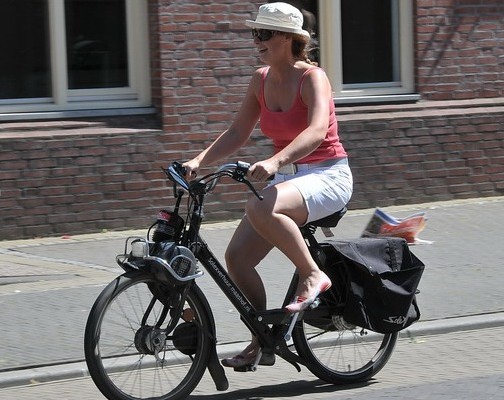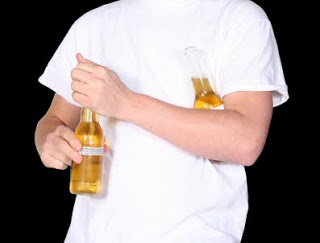Monthly Archives: September 2009

Scooter Safety for Riders and Other Motorists
September 23, 2009
They are popping up everywhere; on college campuses, in urban areas, neighborhoods, and in retirement communities. Whether it’s for fun, cost savings, environmental considerations or out of practicality, scooters and mopeds are growing in use and popularity. While these scooters are zipping about, everyone on the roadways needs to take extra precautions with mopeds and scooters in the driving environment.
Motorist should keep in mind that it is difficult to judge how fast a scooter or moped is traveling.
They are also smaller, difficult to see, and appear farther away than they really are. Maintain your scan of the road to ensure you are aware of their location and continually check your blind spots. Always manage your space cushion and continue to adjust with the flow of traffic as you never know when a scooter will need to make an evasive maneuver. Increase your following distance to a minimum of four seconds in ideal weather conditions and 5 seconds in inclement weather and at night. Even wind can affect the stability and direction a scooter travels. Dim your high beams at night when approaching a moped or scooter as they are more susceptible to their blinding affect.
If traveling by a moped or scooter take extra precautions. Check to make sure you have met all the legal licensing, registration and equipment requirements for your local and state area before travelling on the road. Some vehicles with a motor capacity of 50cc are classified as a motorcycle and require a Motorcycle Safety Course. Know before you go. It is helpful to take a motorcycle practice test prior to taking your safety course.
Make sure your equipment is working and in excellent condition. Poor tire tread, improper inflation, worn brakes and equipment malfunctions can be huge problems on the road. Evaluate your load, cargo and whether to have a passenger as they directly affect your vehicles stability, performance and ability to maneuver.
Wear clothing that will give the greatest protection in a fall. Choose clothing that is light, bright and snug. If traveling during dawn, dusk or nighttime hours, add reflective tape to clothing for increased visibility. Consider boots, a jacket, long pants and gloves. Protect your eyes with safety glasses or goggles.
Head injury is a leading cause of death and disability in moped and motor scooter crashes. Wearing a helmet is the single most effective means to prevent head injury. Ensure that your helmet fits properly and is Department of Transportation (DOT) approved. Helmet use is mandatory in most states.
On the roadway, give yourself plenty of space from all sides. Travel in the center of the lane and if riding with other motor scooters travel in a staggered formation. Always drive defensively; looking for an escape route, should you need to make an evasive maneuver. Keep a three to five second visual scan and be sure to check your blind spots. Turning your headlights on during the day can improve your ability to be seen by pedestrians and other vehicles. When riding, your hands should be on the handlebars and your feet on the floorboards. Watch out for road hazards and defects. Signal well in advance, and consider using hand signals for extra safety.
Be extra cautious when approaching driveways, parking lots, and intersections. Reduce your speed for lower visibility conditions such as dawn, dusk, nighttime and poor weather. Avoid having sudden starts, braking and quick turns as they cause instability.
When reaching your destination, park on level ground, turn off the engine and if you have any passengers let them get off the scooter first.
With awareness and a few extra precautions, mopeds and scooters can operate safely on our roads.

How to Deal with Underage Drinking: Tips for Parents
September 15, 2009
Restricting your teen’s access to alcohol is one of the most important things you can do for them as a parent. There are highly-publicized risks of fatal alcohol poisonings and devastating motor vehicle crashes due to drinking and driving, for example. But there are other, less-publicized risks that could be equally destructive to your teen’s health and well-being, such as increased risk of sexually transmitted diseases and unintended pregnancy, violence and rape, and suicide.
Of course, underage alcohol use has consequences other than legal ramifications:
- Early alcohol use, independent of other risk factors, strongly predicts the development of alcohol dependence. Of all people who ever meet the diagnostic criteria for alcohol dependence in their lifetime, nearly half do so by age 21 and two-thirds by age 25.
- Due to differences between the adult brain and the brain of the maturing adolescent, many young drinkers:
- Are able to consume much larger amounts of alcohol than adults before experiencing the negative consequences of drinking, such as drowsiness, lack of coordination, and withdrawal/hangover effects.
- Are particularly sensitive to the positive effects of drinking, such as feeling more at ease in social situations; young people may drink more than adults because of these positive social experiences (NIAAA, 2009).
- Recent evidence suggests adolescent drinking can inflict permanent damage on the developing brain (National Research Council and Institute of Medicine, 2004).
To help your teen avoid the use of alcohol and its attendant problems, maintain an ongoing, open dialogue about underage drinking and the risks involved. Make sure she understands that underage drinking is never acceptable. The fact that she is at a party or it is a special occasion or that some parents might “look the other way” when their teenage children drink alcohol does not change the fact that underage drinking is illegal and very dangerous. If your teen is attending a party at a friend’s house, make sure her friends’ parents don’t intend to provide alcohol; this is illegal in every state. You might be surprised to discover that other parents plan to provide their teens and their friends with alcohol in a “safe” manner and location. Make sure your teen understands that other adults can’t give her permission to drink alcohol. An alternative is to talk to your teen about organizing a get-together at your own home.
If you and your teen decide to host a party, make a guest list with your teen. Limit the number of teens so you can be sure of adequate chaperonage. Be sure you have contact information on each teen’s parent. Make sure guests and their parents understand that if a teen leaves the party, he won’t be allowed to return and parents will be called. Make sure parents who won’t be chaperoning know the start and end times of the party and will prearrange transportation. Collect all keys so you can keep track of who is arriving and leaving. Keep coats and purses in an area that can be monitored. Speak to each person before he leaves; check for warning signs of impairment. If a guest arrives at the party already under the influence of alcohol or other drugs, keep him there while you call a parent to pick him up. If he leaves and someone is hurt or injured, you could be held responsible.
When your teen spends the night at a friend’s house or goes to a party, call the hosting parent to find out the details. Make sure the hosting parent shares your concerns about the availability of alcohol and that none will be permitted. Ask how much supervision will be provided. Volunteer to chaperone and provide transportation. Let your teen know that you will not approve any outing without sufficient notice so you can speak to the hosting parent first. If your teen will be riding anywhere, at any time, with a friend, make sure it is with someone whose parents do not permit the use of alcohol. Teens are at great risk when riding with other teens, even under the best of circumstances. Talk to your teen about a back-up plan in case something goes wrong.
When your teen is going out for a special event, have her make a record of the planned itinerary for the evening and make sure she agrees to inform you of any changes. Be alert to spontaneous changes in plans on the night of the event; your teen won’t have as much control over the situation if it takes place in an unfamiliar location and/or with people she doesn’t know well. In the excitement of the evening, she could end up in a risky situation before she realizes what is happening.
Create a code with your teen so he can signal for help without attracting the attention of friends. If you don’t know how to text, ask your teen to give you a few lessons; texting is a much easier way for you to communicate than via phone. When you arrive to pick up your teen, he can blame you for having to leave or you can give the excuse of a “family emergency.” Make an agreement that if you do have to pick him up, a discussion about the reason can be tabled until the next morning, when you and your teen are both calm and safe. Otherwise, your teen may avoid calling you for help because he doesn’t want you to know about the circumstances that required the ride home.
And, last but certainly not least, realize that your teen is vulnerable to making poor choices every day. Don’t let your guard down. Finding a balance between being too controlling and allowing too much freedom will require constant effort, but it is a worthwhile endeavor. Your teen’s health and happiness may depend on it.
